Why the “Pearl of Siberia” tomato will definitely not disappoint you: the advantages and disadvantages of a variety that produces a rich harvest
The merit of Siberian breeding scientists is that they create crops that can survive safely and produce large harvests in the harshest conditions. The Siberian collection continues to be replenished with new varieties. For residents of the North, such breeding activities are especially important, because, unlike southerners, they do not have a huge variety of varieties.
The Pearl of Siberia tomato is relatively young, but has already become widespread due to its excellent taste characteristics and unusual shape of the fruit. Let's get acquainted with the general qualities of the variety and reveal the secrets of productivity.
Characteristics and description of the variety
The Pearl of Siberia tomato was born in 2009. This is not a hybrid culture, so it is not necessary to buy seeds for planting; gardeners collect them themselves from the largest fruits. The variety of Siberian breeders is excellent for breeding in regions with an unfavorable climate.
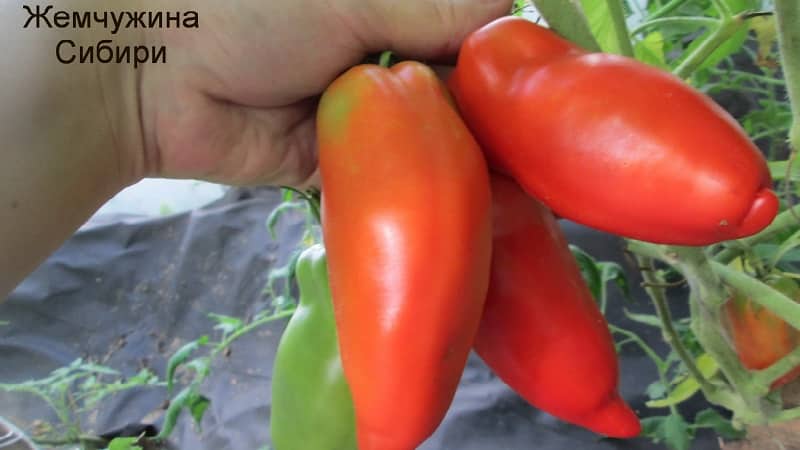
Distinctive features
Indeterminate type, without restriction of main stem growth, so the plant needs a garter. The height does not exceed 2 m, the foliage is moderate, the leaves are medium-sized, light green. The root system is powerful, branched, the inflorescences are simple. The first inflorescence is laid above the ninth leaf, the subsequent ones - every two leaves. Each fruiting branch produces 6–8 fruits.
Ripening time is average, 115 days pass from the moment of germination to the full ripening of the fruit. The lower berries ripen first.
Productivity is high: 3 kg of fruits are collected from one seedling, from 1 sq. m remove 8-9 kg.
The tomato has proven itself to be highly resistant to the main diseases of the nightshade family. It is immune to late blight, gray mold and tobacco mosaic virus. The culture is recommended for cultivation in any region and takes root equally well in greenhouse conditions and in open ground.
Fruit characteristics
The weight of tomatoes reaches 100 g, the shape is elongated, pepper-shaped. The color of ripe vegetables is bright red. The pulp is fleshy, juicy, aromatic, the taste is sweet and sugary. There are many seeds, no more than three seed chambers. The peel is thin but durable, which allows you to transport ripe vegetables over long distances without losing their presentation and taste. Vegetables also have good shelf life.
Universal use of fruits provides the opportunity for culinary diversity. Tomatoes are especially good in hot dishes, but also in fresh salads they perfectly complement other vegetables due to their subtle aroma.
When processed from fruits they obtain delicious ketchups, adjika, sauces, lecho, juices and pasta. Used for pickling and marinades.
The photo shows Pearl of Siberia tomatoes.
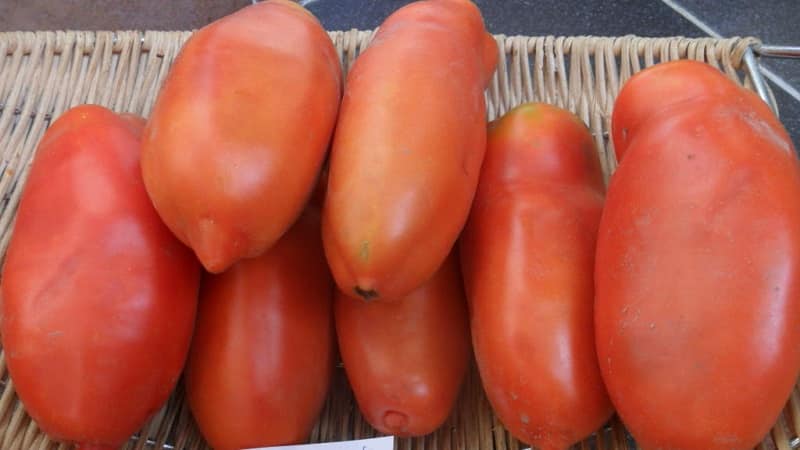
How to grow seedlings
Thanks to proper cultivation The seedlings grow strong and healthy. Care is simple and consists of following basic rules.
Seed preparation
Self-collected seed material requires more careful preparation, rather than purchased. Initially, seeds are rejected in order to immediately dispose of non-viable specimens.The grains are laid out on the table one at a time and carefully inspected for visible damage. Then they check for emptiness inside. Prepare a saline solution from 1 teaspoon and 1 glass of water, place the seeds in it. Those unsuitable for landing will float to the surface after 10 minutes.
An important stage in the preparation of seed material is disinfection. The healthy growth and development of seedlings depends on this procedure. The seeds are disinfected in a weak solution of potassium permanganate for 25 minutes, then washed with running water.
Attention! A highly concentrated solution of potassium permanganate will destroy all seed material.
Before sowing, the seeds are soaked for 10 hours. in a growth stimulator. The stimulator not only improves the germination rate, but also improves immunity. The drugs used are Epin, Zircon or Kornevin.
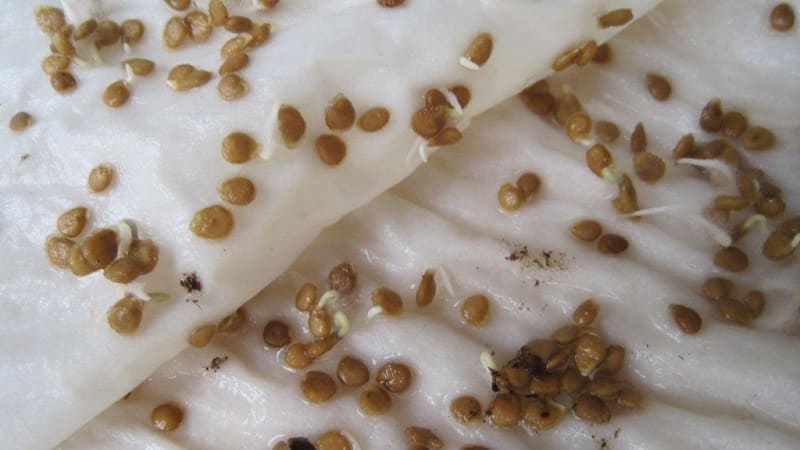
Container and soil
Any container for planting is suitable: when sowing in a common wooden box, the seedlings will need to be picked in the future. If the seeds are placed in individual containers, for example, disposable plastic cups or peat pots, further care of the seedlings is minimized.
Containers are pre-treated dark solution of potassium permanganate to protect seedlings from fungal infections.
The soil is prepared fertile, from garden soil mixed with peat, humus and river sand. River sand is added to make the soil lighter. The resulting mixture is mixed with a tablespoon of wood ash to saturate the soil with additional nutrients. The soil is spilled with a hot solution of potassium permanganate to destroy pathogenic flora. After the soil has cooled, it is laid out in planting containers.
Reference. In addition to its beneficial properties, ash serves as a neutralizer - it reduces the acidity of the soil.
Sowing
Seed material is sown to a depth of 1.5 cm, sprinkle peat on top and lightly compact. Moisten with warm, settled water from a spray bottle and cover the containers with film so that the seeds germinate faster. Before emergence, the room temperature should be at least +25 degrees.
Seedling care
In a week the first shoots will appear. The containers are immediately moved to the windowsill, and the film is removed. If there is not enough light, the sprouts will stretch and weaken. To prevent this, install additional lighting.
Water when dry top soil layer. Use a shallow watering can and warm, settled water. After watering, the soil is loosened superficially to saturate the soil with oxygen.
When two true leaves appear, the seedlings are picked, seating in separate containers. During picking, weak and unhealthy seedlings are disposed of. The remaining plants are transplanted into separate containers along with a lump of earth.
Reference. When transplanted with a clod of soil, the plants quickly adapt to the new location.
With poor growth two weeks after picking seedlings are fed with liquid fertilizer for tomatoes.
10 days before transplanting into the ground seedlings are hardened off outdoors. To do this, it is taken out into the open air for 40 minutes, gradually increasing the time every day to 10 hours. The night temperature in the room is reduced to +13 degrees.
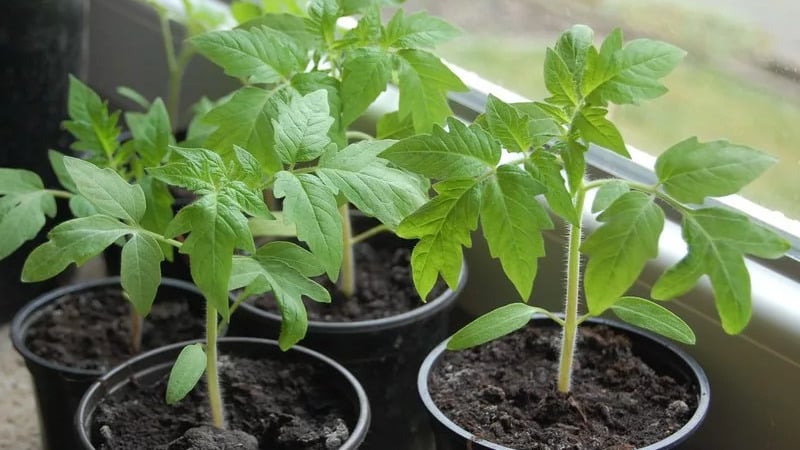
How to grow tomatoes
By the time of planting in the ground, the seedlings should have at least 5–7 true leaves and a formed root system.
Landing
Tomato beds are formed in a sunny place no through winds. The soil is dug up in advance, adding humus.
Replant on a cloudy day or after sunset into holes 20 cm deep with a distance of 50 cm between seedlings. Row spacing is formed at least 70 cm. With a smaller distance, plantings thicken, which increases the risk of developing fungal infections.
Other varieties of pepper tomatoes:
After transplant the plants are left unattended for two weeks. During this time, they fully adapt to new conditions.
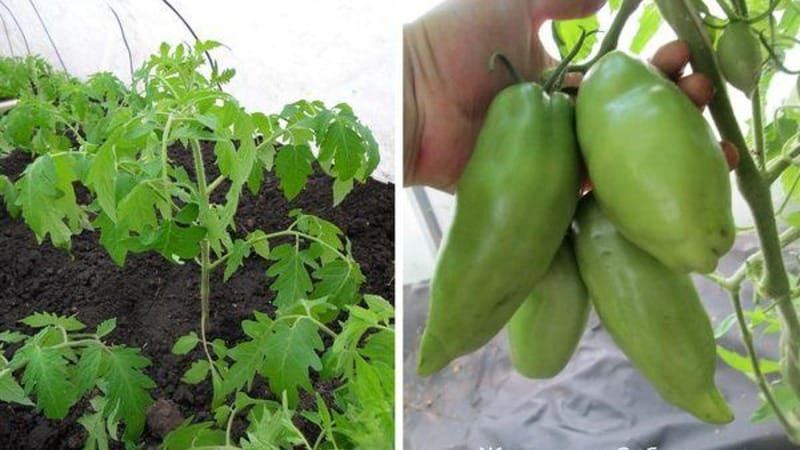
Further care
After rooting, the seedlings are regularly watered – at least twice a week with settled water. The water is kept in large barrels. Watering is carried out in the morning, since the daytime sun can burn the foliage.
Reference. If the barrels are exposed to the sun, the water will not only settle, but will also heat up. Warm water has a beneficial effect on tomato roots.
After watering, the wet soil is loosened and remove weeds with roots. Loosening improves the air permeability of the soil, and weeding frees the beds from unnecessary vegetation. In addition, weeds often contribute to the development of fungal infections.
Mulching holes helps them stay moist for a long time. This is especially important on dry days with high evaporation.
Tomatoes are fed with a complex of mineral fertilizers or organic matter.. Feed at least three times per season: during flowering, formation of ovaries and at the time of fruiting. During flowering, they are fertilized with phosphorus elements, and during fruiting, potassium substances are added. At the moment of ovary formation, the tomato accepts organic matter well, for example, bird droppings or mullein infusion. The ratio of organic compounds to water is 1:15.With a highly concentrated solution, plant roots can get burned.
Features of cultivation and possible difficulties
The bush is formed into one stem, removing all the lower leaves up to the first fruitful branch. Tomatoes are pruned regularly, once every 10–12 days, early in the morning, so that the wounds have time to heal by evening. To avoid infections, the cut sites are sprinkled with ash. Stepchildren are removed when they are 3–5 cm long. If longer shoots are removed, the seedlings will have a harder time withstanding the procedure.
High growth of tomatoes The Pearl of Siberia requires a mandatory garter. When transplanting, a wooden or metal support is installed next to each seedling, and the main stem and branches are tied to it as they grow.
Another option is fixing to a trellis. Metal supports are installed on different sides of the beds and a wire is pulled between them, to which the stem and branches are fixed with fabric tapes. This method is less traumatic for plants.
Read also:
Diseases and pests
The strong immunity of the Pearl of Siberia variety to diseases makes care easier. Plants are usually not affected by diseases, so preventive measures are quite sufficient. By following the regime of watering, weeding and loosening, the risk of infection is reduced. Also, as a preventive measure, the bushes are sprayed with an infusion of onion peels and treated with a weak solution of manganese. Tea bags soaked in iodine are hung in the greenhouse. According to experienced gardeners, they protect against fungal spores.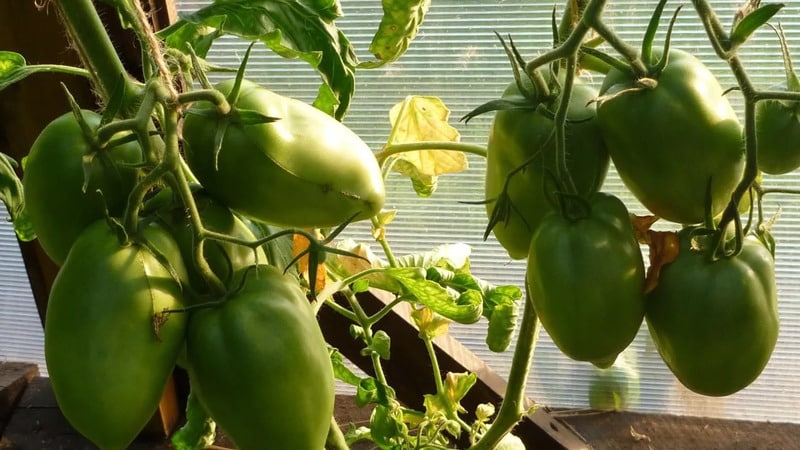
Pests to watch out for slugs, aphids and Colorado potato beetles.A soap solution made from one piece of laundry soap dissolved in a bucket of warm water is used against aphids. The stems of seedlings are treated with it. Mulching the beds and spraying with garlic infusion helps prevent slugs. This infusion is easy to prepare: chop 3 large heads of garlic and add 10 liters of water. Leave for a day, then spray the tomatoes.
Reference. Slugs are also dangerous because they transmit fungal and viral infections from diseased plants to healthy ones.
The Colorado potato beetle is fought with insecticide "Prestige". Another effective method of pest control is daily inspection of seedlings.
Nuances for open ground and greenhouse conditions
In the greenhouse, plants reach 2 meters, while street seedlings grow only up to 1.5 m. Therefore, the tops of greenhouse plants are pinched, artificially limiting their growth. Otherwise, nutrients will be spent on the growth and development of excess green mass, and the fruits will suffer from a lack of nutrients.
Closed structures are ventilated every dayso that humidity and temperature do not exceed the norm. With high humidity, fungal spores quickly develop and greenhouse pests appear, which are dangerous for tomatoes.
Harvesting and application
Harvest begins in July. The fruits should be picked slightly unripe, when they just begin to turn brown. Vegetables collected at this stage are stored for four weeks.
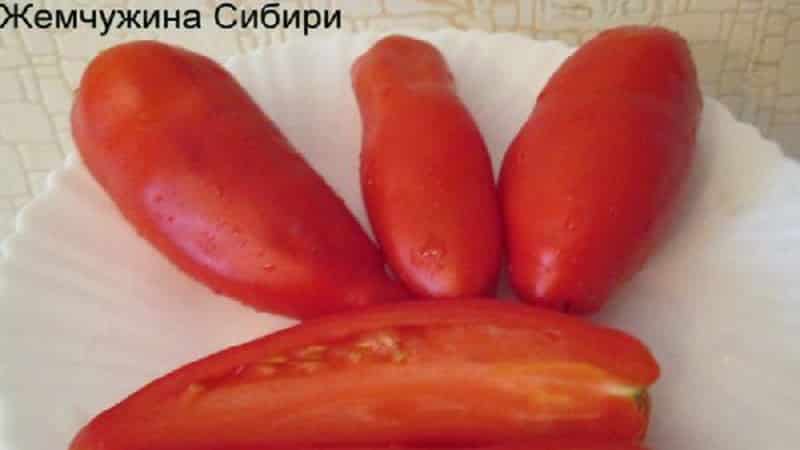
They are used in cooking as much as your imagination allows.. In hot dishes, the fruits of the Pearl of Siberia variety perfectly retain their taste. Their inherent subtle aroma is not lost in pickles and processed products: ketchups, adjika, pasta and juices.
During long-term transportation Ripe vegetables do not lose their presentation.
Advantages and disadvantages of tomato
Like every culture, the Pearl of Siberia has its pros and cons. The main advantage of the Siberian tomato is its cold resistance. Let's consider other advantages:
- ability to settle down in any region;
- strong immunity to diseases;
- high yield;
- the ability to form ovaries under any conditions;
- unpretentious care;
- unusual shape of the fruit;
- excellent taste;
- long-term storage;
- possibility of transportation;
- universal application;
- opportunity to collect seeds yourself.
The disadvantages include mandatory staking of tall seedlings and regular pinching.
Farmer reviews
Positive reviews are the best indicator of quality. Here are some opinions of gardeners.
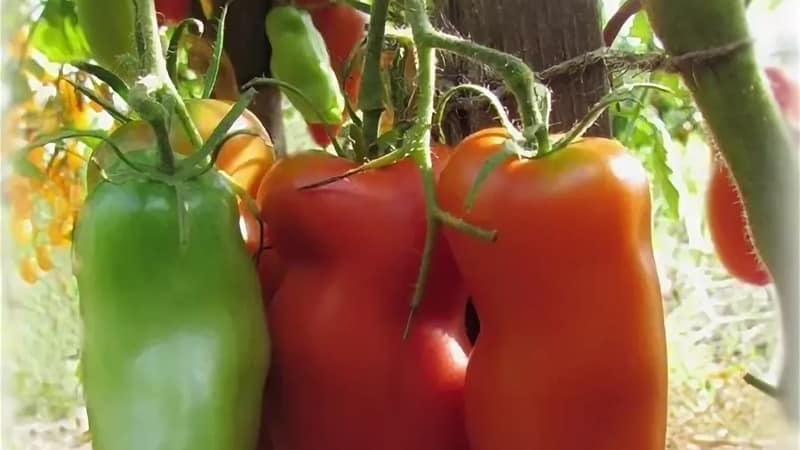
Maxim, Severodvinsk: “After several years of growing tomatoes, I realized one thing: there is no better variety for cool regions with short summers. In addition, the tomato is disease resistant and easy to care for, which suits me quite well. From the harvest I make preparations for the winter, and summer salads with it are very tasty.”.
Lilia, Arkhangelsk: “The tomato is very tasty and does not suffer from late blight. I chose it out of fear of losing the harvest from sudden cold weather, as often happens in our climate. I always plant a lot of tomato bushes, so it’s hard to see them destroyed by bad weather. With the Pearl of Siberia, there is never any doubt that fruiting will be abundant and of high quality.".
Conclusion
The Pearl of Siberia tomato easily takes root in cold regions and pleases with abundant fruiting. The crop is distinguished by its high resistance to diseases, the ability to form ovaries in unfavorable weather and simple agricultural techniques.And ripe vegetables surprise not only with their excellent taste, but also with their unusual shape. They are great for preparing any dishes. The Pearl of Siberia variety is a real treasure for both northern residents and residents of the warm south.